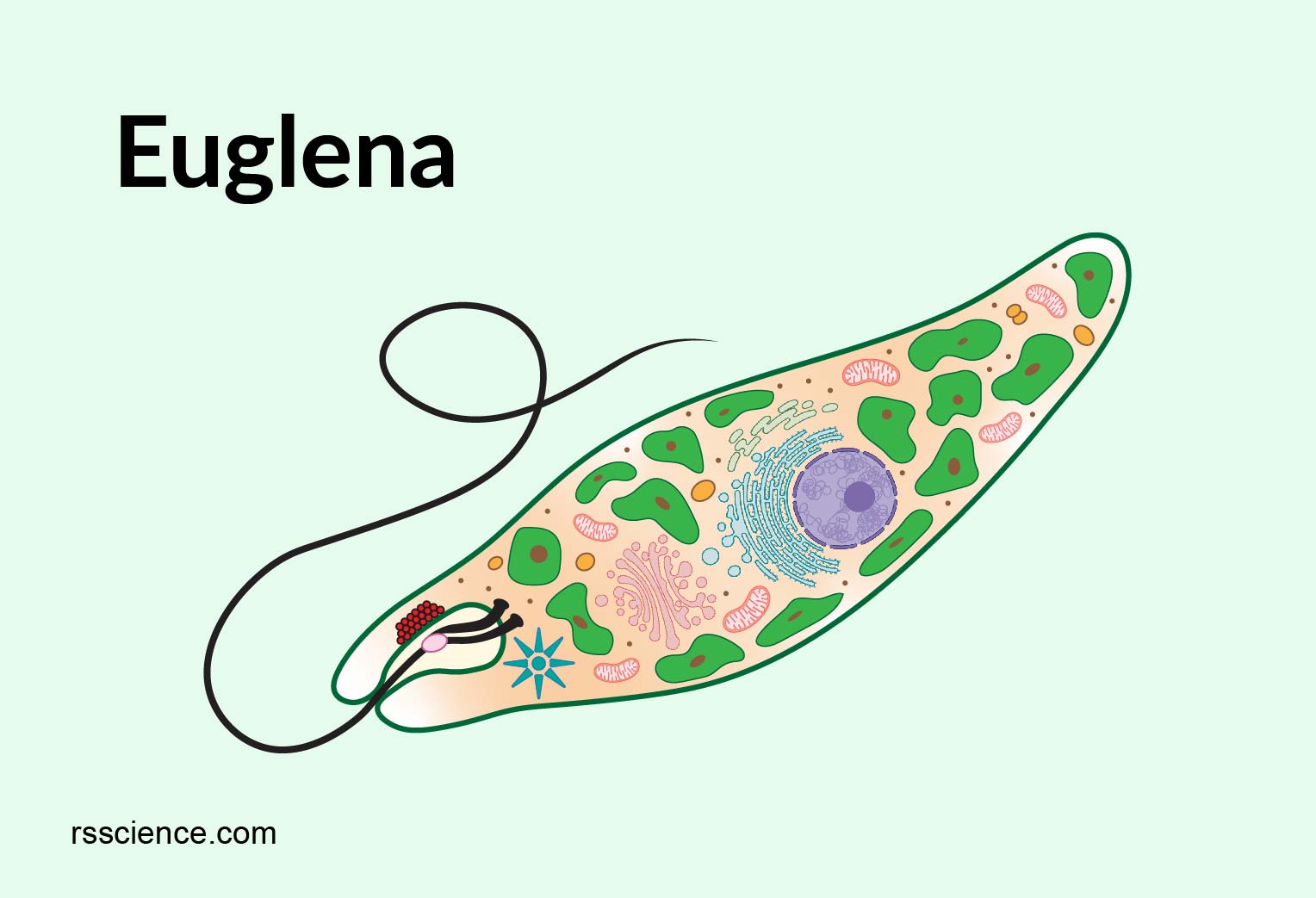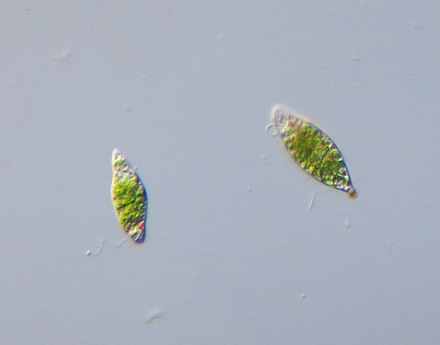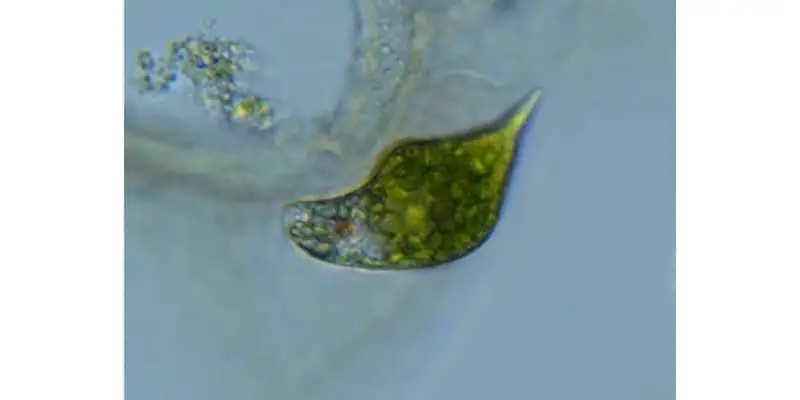What Does Euglena Gracilis Do for the Environment
Triclosan is an antimicrobial chemical present in consumer products that is frequently detected in aquatic environments. What Kingdom do euglena belong to.

Euglena Under A Microscope Anatomy Reproduction Facts Rs Science
A Euglena can also adapt itself to.

. Motile microorganisms such as the green Euglena gracilis use a number of external stimuli to orient in their environment. Euglena is a very important organism within the environment as it is able to photosynthesize thus taking in carbon dioxide and releasing oxygen into the atmosphere so that other organisms can survive. How do organisms respond to their environment.
Euglena has various powerful benefits ranging from health cosmetics to sustainability. It helps in excreting excess water and waste matter from the body of the Euglena. Toxic Euglena bloom Toxic bloom caused by Euglena a photosynthetic protist.
They are found in freshwater saltwater marshes and also in moist soil. Most species of Euglena have photosynthesizing chloroplasts within the body of the cell which enable them to feed by autotrophy like plants. Labscale wetland bioreactors were created under various.
Euglena gracilis can grow in conditions of 40 carbon dioxide. Euglena are usually found to live in fresh water streams and in some fresh water ponds. Euglena gracilisand other species of Euglena are characterized by the presence of a pellicle.
It is known that their photosynthetic capability is 60-fold of that of rice plants. They respond to light with photophobic responses photokinesis and phototaxis all of which can result in accumulations of the organisms in suitable habitats. This means it is able to consume food such as green algae and amoebas by phagocytosis engulfing cells but they are also able to generate energy from sunlight by photosynthesis which is perhaps the preferred method.
Propel and make the euglena move. They respond to light with photophobic responses photokinesis and phototaxis all of which can result in accumulations of the organisms in. This protist is both an autotroph meaning it can carry out photosynthesis and make its own food like plants as well as a heteroptoph meaning it can also capture and ingest its food.
What organelle carries out photosynthesis. Up to 24 cash back Structure and Function. They possess the characteristic features of plants and animals.
Since Euglena is a eukaryotic unicellular organism it contains the major organelles found in more complex life. Even so they convert carbon dioxode to oxygen in a very short time scale. Euglena is unusual in the fact its both heterotrophic like animals and autotrophic like plants.
What does a euglena do. Up to 24 cash back However they are most commonly found in water bodies such as streams ponds and lakes. Most euglenoids are photosynthetic.
It has properties of both plants and animals as it can make food like plants with the help of chloroplast but can also take food from the outside environment when devoid of sunlight. In this research we investigated the role of a common freshwater microalgae species Euglena gracilis for triclosan uptake and transformation in openwater treatment wetlands. An idea habitat for Euglena would have plenty of exposure to the sunlight such as a surface of a pond for the organism to conduct photosynthesis as well as be rich in organic matter where it can find carbon-based food.
Euglena has no cell wall. What does the flagellum do. A few of them are heterotrophs.
This means it is able to consume food such as green algae and amoebas by phagocytosis engulfing cells but they are also able to generate energy from sunlight by photosynthesis - which is perhaps the preferred method. As a food supplement Euglena contains Paramylon β-glucan which helps remove undesirable substances like fats and cholesterol enhances the immune system and reduces the level of uric acid in the blood. They respond to their environment by using their special sensorsfor example euglena detects light using the special sensors to feed it self.
Up to 24 cash back Euglena. Euglena is unusual in the fact its both heterotrophic like animals and autotrophic like plants. Beautiful Eu Eye glena is a single-celled microscopic algae that is both heterotrophic must consume food and autotrophic can make its own foodTheir chloroplasts trap sunlight and use it to carry out photosynthesis.
Euglena has plastids and performs photosynthesis in light but moves around in search of food using its flagellum at night. My Résumé Euglena gracilis comment share Lived In Fresh water environments. Together with their flagella the pellicle contributes to the locomotion of euglenid cells and can give the cell a striped.
Such a consequence is prevented due to presence of a special organelle known as contractile vacuole. When acting as a autotroph the. It is a star-shaped structure at the rear portion of the cell.
Gracilis is common in laboratory demonstrations and a number of species are used to study cell growth and metabolism in various environmental conditions. Euglena gracilis is a member of the euglenids an abundant and well-studied lineage of marine and freshwater protists characterized by the presence of a pellicle a series of proteinaceous strips beneath the outer membrane. Euglena can suck up so much water through osmosis that it can burst.
Euglena gracilis is a freshwater species of single-celled alga in the genus EuglenaIt has secondary chloroplasts and is a mixotroph able to feed by photosynthesis or phagocytosisIt has a highly flexible cell surface allowing it to change shape from a thin cell up to 100 µm long to a sphere of approximately 20 µm. Where do they live. Type of nutrition in which organisms can make their own food.
There are around 1000 species of Euglena found. Motile microorganisms such as the green Euglena gracilis use a number of external stimuli to orient in their environment. The species Euglena gracilis has been used extensively in the laboratory as a model organism.

Photomicrographs Of A Euglena Gracilis B E Viridis C E Download Scientific Diagram

Euglena Green And Ciliate In The Natural Environment 3d Illustration Natural Environment Nature Stock Images Free

How Do Euglena Obtain Their Energy And Move Explained Outlife Expert

Enrich Your Mind With These Mindblowing Euglena Facts Biology Wise

Euglena Gracilis Cell Morphology Euglena Cells From Maximal A And Download Scientific Diagram

Culture Of Euglena Gracilis Z Cells Download Scientific Diagram

No comments for "What Does Euglena Gracilis Do for the Environment"
Post a Comment